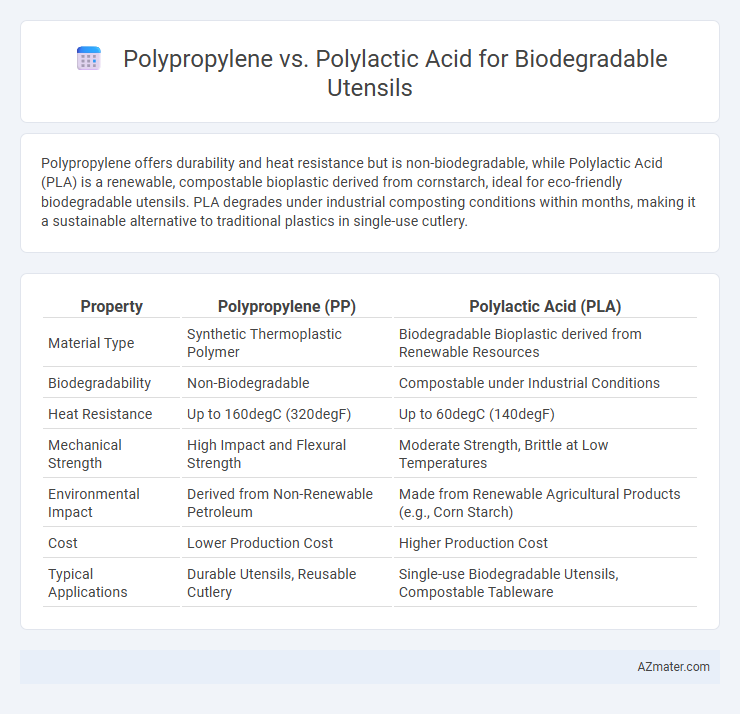Polypropylene offers durability and heat resistance but is non-biodegradable, while Polylactic Acid (PLA) is a renewable, compostable bioplastic derived from cornstarch, ideal for eco-friendly biodegradable utensils. PLA degrades under industrial composting conditions within months, making it a sustainable alternative to traditional plastics in single-use cutlery.
Table of Comparison
| Property | Polypropylene (PP) | Polylactic Acid (PLA) |
|---|---|---|
| Material Type | Synthetic Thermoplastic Polymer | Biodegradable Bioplastic derived from Renewable Resources |
| Biodegradability | Non-Biodegradable | Compostable under Industrial Conditions |
| Heat Resistance | Up to 160degC (320degF) | Up to 60degC (140degF) |
| Mechanical Strength | High Impact and Flexural Strength | Moderate Strength, Brittle at Low Temperatures |
| Environmental Impact | Derived from Non-Renewable Petroleum | Made from Renewable Agricultural Products (e.g., Corn Starch) |
| Cost | Lower Production Cost | Higher Production Cost |
| Typical Applications | Durable Utensils, Reusable Cutlery | Single-use Biodegradable Utensils, Compostable Tableware |
Introduction to Biodegradable Utensils
Biodegradable utensils offer an eco-friendly alternative to traditional plastics by decomposing naturally and reducing environmental pollution. Polypropylene, a common plastic, provides durability and heat resistance but has limited biodegradability, resulting in long-term waste accumulation. Polylactic Acid (PLA), derived from renewable resources like corn starch, biodegrades efficiently under industrial composting conditions, making it a preferred choice for sustainable disposable cutlery.
Overview: Polypropylene and Polylactic Acid
Polypropylene (PP) is a petroleum-based polymer widely used for durable, heat-resistant utensils due to its chemical stability and low cost. Polylactic Acid (PLA) is a biodegradable thermoplastic derived from renewable resources such as corn starch or sugarcane, favored for eco-friendly disposable utensils because it decomposes under industrial composting conditions. While PP offers superior mechanical strength and thermal resistance, PLA provides environmental benefits by reducing plastic waste, making it suitable for single-use biodegradable cutlery.
Environmental Impact Comparison
Polypropylene (PP) utensils are derived from petrochemicals, resulting in longer degradation times and contributing to plastic pollution due to their non-biodegradable nature. Polylactic acid (PLA) utensils, made from renewable resources like corn starch, offer compostability under industrial conditions, significantly reducing landfill accumulation and greenhouse gas emissions. Life cycle assessments reveal PLA's lower carbon footprint and enhanced potential for circular economy integration compared to traditional PP utensils.
Biodegradability and Compostability
Polypropylene (PP) is a petroleum-based plastic known for its durability but lacks significant biodegradability, leading to long-term environmental persistence. Polylactic Acid (PLA), derived from renewable resources like corn starch, offers superior biodegradability and compostability under industrial composting conditions, breaking down into non-toxic residues within 90 to 180 days. The compostability certification of PLA ensures it meets international standards such as ASTM D6400, making it a preferable choice for eco-friendly, biodegradable utensils compared to non-biodegradable polypropylene.
Manufacturing Process Differences
Polypropylene (PP) utensils are produced through a traditional injection molding process that involves high temperatures and petrochemical-based raw materials, enabling fast cycle times and high-volume manufacturing. In contrast, Polylactic Acid (PLA) utensils require fermentation of renewable resources like corn starch or sugarcane, followed by extrusion and thermoforming, which generally involves lower temperature processing but more complex biopolymer handling. The PLA manufacturing process emphasizes sustainability with biodegradable feedstocks, while PP relies on conventional petrochemical methods, impacting energy consumption and environmental footprint throughout production.
Performance and Durability in Utensils
Polypropylene offers superior performance in reusable utensils due to its high impact resistance, flexibility, and heat tolerance up to 100degC, making it ideal for repeated use and dishwasher safety. Polylactic Acid, derived from renewable resources, excels in biodegradability but has lower heat resistance (around 60degC) and brittleness, limiting its durability in long-term or high-temperature utensil applications. The choice between polypropylene and polylactic acid hinges on balancing sustainability goals with the required mechanical strength and thermal stability for utensil performance.
Safety and Food Contact Compliance
Polypropylene (PP) is widely recognized for its durability and compliance with FDA and EU food contact regulations, ensuring high safety standards for reusable utensils. Polylactic Acid (PLA), derived from renewable resources, offers compostability but may have lower heat resistance and stricter regulatory requirements under EU's EN 13432 standard for food contact materials. Safety considerations for biodegradable utensils emphasize PP's proven inertness and chemical stability, while PLA demands careful assessment for migration limits and biodegradation conditions in food-related applications.
Cost Analysis: PP vs PLA Utensils
Polypropylene (PP) utensils typically have a lower production cost due to cheaper raw materials and established manufacturing processes, making them economically favorable for large-scale use. Polylactic acid (PLA) utensils, derived from renewable resources like corn starch, incur higher costs owing to more complex bioplastic production and limited supply chains. Despite the higher price, PLA offers biodegradability advantages, which can justify the cost premium in eco-conscious markets.
Market Trends and Consumer Preferences
Polypropylene remains dominant in the biodegradable utensil market due to its durability and low cost, while polylactic acid (PLA) is gaining traction for its compostability and eco-friendly attributes. Consumer preferences increasingly favor PLA as awareness of plastic pollution rises, driving demand for utensils made from renewable resources and certified compostable materials. Market trends indicate a growing shift toward PLA-based products in food service sectors seeking sustainable packaging solutions that align with regulatory pressures and green initiatives.
Future Outlook in Sustainable Utensil Materials
Polylactic Acid (PLA) demonstrates significant potential as a sustainable alternative to polypropylene in biodegradable utensils due to its renewable origin and compostability within industrial facilities. Advancements in PLA formulations aim to enhance mechanical strength and thermal resistance, addressing current limitations for broader application. Growing regulatory support and consumer demand for eco-friendly packaging will likely accelerate PLA adoption, positioning it as a key material in the future of sustainable utensil production.

Infographic: Polypropylene vs Polylactic Acid for Biodegradable Utensil
 azmater.com
azmater.com